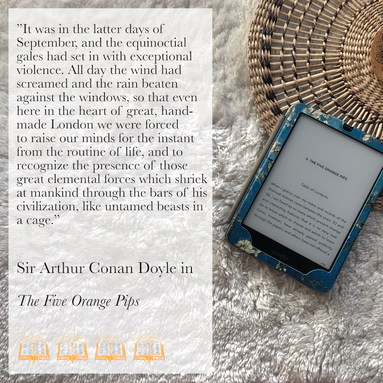by Sir Arthur Conan Doyle

Sir Arthur Conan Doyle’s The Five Orange Pips was first published in the UK in The Strand Magazine in November 1891 as part of what is now one of the best historical fiction series with the iconic characters Sherlock Holmes and Dr Watson. Modern writing at the time, it is now categorized under historical fiction short stories. The Scottish writer was born in Edinburgh in 1859 to nine siblings and was knighted in 1902 after his involvement in and propaganda for in at least one of his books regarding the South African Boer War. He survived his first wife and remarried, and when his son died in the war of 1918, he turned to spiritism and mysticism. Many of his Sherlock Holmes stories feature paranormal activities which the clever Sherlock Holmes cuts through and proves to have causes in this world.
If you enjoy historical fiction short stories with a tinge of horror, a cunning protagonist, and an unknown, all-pervasive enemy, this short story is made for you.
Synopsis of The Five Orange Pips
Though the Sherlock Holmes stories are in essence a series, one does not have to read them in order, or read the others to understand the one. They are standalone stories, as well.
On a stormy September day, when Sherlock is reading one of W. C. Russels “fine sea stories,” along with a heavy gust of wind and a dripping coat, the detective Sherlock Holmes’ new client John Openshaw brings a complex case of dire need for action. The character Dr. John Watson, who is Sherlock’s colleague in the case, also functions as the logically thinking narrator. The client explains that he received five orange pips, like his father, who had died shortly after, and his uncle, same. His uncle, the first to receive this hereditary death threat, had known something about his opponent, but not disclosed the information before burning a bunch of secret papers he had kept from anyone’s view. John Openshaw had managed to save a piece of paper, which had not burned when his uncle destroyed them. Sherlock advises the client to act immediately and, with detailed advice, sends him off into the night.
Evaluation of The Five Orange Pips
Not without reason part of one of the best historical fiction series, all time

Having been written and set in times which would now be considered historical fiction, The Five Orange Pips matches its genre, particularly in world view and word choice. Though part of the renown Sherlock Holmes series, this short story can be read as a standalone, and is particularly suited as an alternative introduction to the series because Dr Watson recites what he remembers of his initial analysis of Sherlock’s character from A Study in Scarlet. The Five Orange Pips contains some violence, and there are no magical elements, no romance, and it’s clean reading. The writing has a genuine historical feel that comes easily, and matched every expectation I had considering its genre.
Characters With Depth
The characters jumped right off the page, though I’ve read and reread the entire Sherlock Holmes series multiple times and was therefore right with them from the first sentence. In this story, Holmes asks Dr. Watson to recite Dr. Watson’s description of Holmes’ character, which he recites, laughing, and which tells us as much of Dr. Watson as it does of Holmes.
“It was a singular document. Philosophy, astronomy, and politics were marked at zero, I remember. Botany variable, geology profound as regards the mud-stains from any region within fifty miles of town, chemistry eccentric, anatomy unsystematic, sensational literature and crime records unique, violin player, boxer, swordsman, lawyer, and self-poisoner by cocaine and tobacco. Those, I think, were the main points of my analysis.”
Sir Arthur Conan Doyle in The Five Orange Pips
The story being very short, there were no profound character arcs to speak of. Mr. Openshaw did calm down after speaking with Sherlock, which could be considered a return to logical thinking, if one takes into account the many years in which he feared the unseen enemy he considered unbeatable up to that point. Sherlock is humbled by the events after Mr. Openshaw leaves his consultation, and Dr. Watson, though involved emotionally, does not undergo any changes in character. What there is that can be termed an arc, however, is definitely satisfying.
Suspenseful plot and karmik themes

After an intro that modern readers would consider longish, at best, the story gripped me. One could consider several items a theme in this one. For one, that one should never leave important matters to the last second, and another, that karma takes care of bad people, though Doyle might not have termed it thus. Both are well expressed throughout the story, and there were no inconsistencies in this or any other regard. The theme that runs through all Sherlock Holmes stories, that of using the mind and focus to be able to solve any crime or come to any knowledge, is expressed particularly in the conversations Sherlock has with Mr. Watson, because Sherlock is thus forced to explain his thought process.
Varied Pacing
The pace picked up rapidly when Sherlock sent Mr. Openshaw home with his advice. It drags a little after Openshaw leaves, but the narrator manages to catch us again when Sherlock takes action and leaves the narrator, because we want to find out what he does.
Historical, image-fille prose
The writing style is old with a pinch. Doyle is strong on vivid imagery which set the scene, as in the beginning, when the reader is lured into the London setting.
"It was in the latter days of September, and the equinoctial gales had set in with exceptional violence. All day the wind had screamed and the rain beaten against the windows, so that even here in the heart of great, hand-made London we were forced to raise our minds for the instant from the routine of life, and to recognize the presence of those great elemental forces which shriek at mankind through the bars of his civilization, like untamed beasts in a cage."
Sir Arthur Conan Doyle in The Five Orange Pips
His lexical choices in the context of the 1800s give a genuine historical feel, such as when he describes the shocked expression of Mr. Openshaw’s uncle when he opens the death threat.
"His lip had fallen, his eyes were protruding, his skin the color of putty, and he glared at the envelope which he still held in his trembling hand."
Sir Arthur Conan Doyle in The Five Orange Pips

A quick search of the word ‘putty’ shows its use in 1886 for “yellowish grey,” which, in its specificity and historical accurateness, suits the imagery better than any other word would. One is not only given the precise color, but the state of industrialization, and thus a very specific time frame, with this ‘simple’ description. And this is what historical fiction must do: give us the impression of the time, immerse us in it. Similarly, the lexical choice when his uncle’s face “glisten[ed] with moisture, as though it were new raised from a basin,” reminds the modern reader that running water was, if at all present in the homes of the time, a rare thing even among the richer population, which we assume his uncle belonging to. These are only two of many examples even in this short story. The prose is immersive and delicious for attentive historical fiction readers.
Strange Impact
The story left me like a whole bar of chocolate would: satisfying gusto, with a hint of a belly ache, but still wanting more.
Recommendable historical fiction short story
I highly recommend The Five Orange Pips to anyone looking for a short, immersive, and well-crafted historical fiction read. Consider buying the whole Sherlock Holmes selection though (I did), because, if you are anything like me, you will be wanting more.
If you decide to read this book, I’ll be very happy to read your thoughts about it in the comment section below!
Golden Books Rating of The Five Orange Pips


Four of five Golden Books for The Five Orange Pips by Sir Arthur Conan Doyle.
Violence: yes
Profanity: little
Romance: no
Nudity/sex: no
Supernatural: no
Racism: yes
The only drawback is the longish introduction.
Like what you're reading? Share it with someone who might be interested:

Write a comment